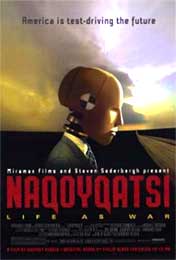 The third film in director Godfrey Reggio and composer Philip Glass’s wordless, impressionistic “Qatsi” trilogy, following the legendary KOYAANISQATSI and POWAQQATSI. I may be cheating in reviewing NAQOYQATSI as a horror movie, but it is one in many ways, as well as one of the most challenging, visionary and awe-inspiring achievements in 2002.
The third film in director Godfrey Reggio and composer Philip Glass’s wordless, impressionistic “Qatsi” trilogy, following the legendary KOYAANISQATSI and POWAQQATSI. I may be cheating in reviewing NAQOYQATSI as a horror movie, but it is one in many ways, as well as one of the most challenging, visionary and awe-inspiring achievements in 2002.
Any true film fan knows of Godfrey Reggio’s KOYAANISQATSI, a wordless cascade of images set to a hypnotic Philip Glass score. The film was quite innovative when first released in 1983, and still packs a punch. POWAQQATSI followed in 1988, a lesser known but equally powerful look at the exploitation of third world cultures, again boasting superb music by Glass. Now comes NAQOYQATSI; the 14-year wait was certainly excessive, and testifies to the difficulties inherent these days in financing “artistic” works like these. It was filmmaker Steven Soderberg (SEX, LIES AND VIDEOTAPE, TRAFFIC) who deserves credit for finally getting the ball rolling, and bringing the mighty Miramax Films on board as financiers.
Whatever flaws one assigns NAQOYQATSI (“nah-KOY-kahtsee”), audacity isn’t one of them. It takes balls to indict the entire human race, and that’s precisely what Reggio has done. His primary concerns are human ignorance and the spread of technology, which apparently spell our doom. Still, Reggio’s film is far from a straightforward polemic; other than the definition of “Naqoyqatsi” that appears before the end credits (it’s from the Hopi language, meaning “Life as War”), there is no text or narration to guide us through Reggio’s ceaseless flood of imagery. Quite simply, we’re intended to draw our own conclusions based on the none-too-optimistic overriding theme. You can be outraged (quite a few people have) or simply ignore it (as, again, quite a few have done) but it would be difficult to deny the force with which it’s presented.
There is a narrative of sorts, divided into three more-or-less distinct sections. After a prologue that juxtaposes a three dimensional rendering of Breugal’s painting “The Tower of Babel” with an abandoned ruin, a tossing sea and an eerie mass of faceless, desaturated zombies, we’re into part one, dealing with the corruption of language. Part two is concerned with sports, celebrity and mankind’s attendant love of conquest and superficiality. Part three shows the consequence of such concerns: the apocalypse, with lots of explosions and wonton destruction.
But then, that’s just my interpretation. Everyone’s journey through NAQOYQATSI will be different, and, as with all truly great films, it’s the experience that matters and not the explanation.
Godfrey Reggio, aided by one of Philip Glass’s finest-ever scores (as was already proven by the other Qatsi films, Reggio clearly inspires Glass to do his best), has created a groundbreaking yet totally “with-it” film. With the recent explosion in digital technology, it seems appropriate that the entire movie is composed of “found” images (TV commercials, news broadcasts, stock footage) digitally manipulated in various ways to turn them into familiar-yet-disconcerting things.
A woman eating a sandwich is transformed into a smirking gargoyle; countless letters literally jump off their respective pages to form a bottomless pit into which we descend; synthetic movie stars interact with live-action talk show hosts; dozens of corporate logos—McDonald’s, Disney, Enron, etc.—spiral through the air one after the other (a pitch-perfect visual representation of what we experience, mostly on a subconscious level, each day). And so on. There is simply too much here to be absorbed in one sitting (let alone two or three), so be ready to view NAQOYQATSI multiple times.
Vital Statistics
NAQOYQATSI
Miramax Films
Director: Godfrey Reggio
Producers: Joe Beirne, Godfrey Reggio, Lawrence Taub
Screenplay: Godfrey Reggio
Visual Designer: Jon Kane
Music: Philip Glass
Editor: Jon Kane
Cinematography: Russell Lee Fine
